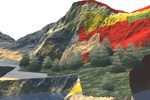

Last week a newspaper report indicated that a team consisting of “British cartographers, experts in geopolitical policy, and members of the Collins Geo division of Harper Collins” all met to work on the establishment of territorial boundaries for the new country of South Sudan. Their interest was to create new maps and materials for an upcming atlas.
What they quickly discovered was that mapping a new territorial border would require certain assumptions, observations and decisions that might not actually occur, since they hoped to present their work for inclusion into about-to-be published products. But they also came within the well known circle of cartographic phenomenon that taunts all map makers – trying to represent the real world on a piece of paper. Although that discussion lies within the realm of cartography and geodesy, I’ll turn attention toward another direction – those other countries similarly impacted and challenged today.
When problems arise with respect to the boundaries between North Korea and South Korea, many people point to the fact that “the maps said”, as if the real positions could be accurately represented, through a map representation. Do you suppose both North and South Korea set their GIS software to the same datum when mapping? Does one side use satellite imagery to determine boundaries while the other uses GNSS survey methods?
But the marking of a line between North and South Sudan entails similarities experienced elswhere around the world. Thailand and Cambodia are locked in a conflict that also surrounds boundaries. Each side claims the ‘line’ is somewhere different than the other.
The 8,891 kilometer Canada-U.S. boundary is often debated, “A boundary is not a border. A border is fluid: you enter “Canada,” for example, when you walk into a Canadian embassy in a foreign country or pass through Canadian Customs and Immigration in a foreign airport. By contrast, a boundary is resolutely fixed; it is, in the words of Brian Ballantyne, Advisor to Canada’s IBC Commissioner, an “impossibly thin membrane, phenomenal in length and height but with no width.” Indeed, some have argued that that particular line, originally surveyed without the benefits (and accuracy) of GNSS might very well be located incorrectly – alas the two countires have decided they have other important things to think about – and the King of The Netherlands acted as arbitrator to make it so.
Today we can see many nations scrambling to determine boundaries in the arctic, an activity that only became more tenuous as the ice cap melts, with access to the region becoming accessible. When I plugged the words ‘territory, dispute and boundary‘ into a search engine, there were 13.4 million records returned.
Indeed, there are boundary conflicts and issues in Guatamala, Nepal, India, Pakistan, China, North Korea, Israel and many other countries. For each of these disputes we need to ask ourselves, “what is the role maps are playing” in either prolonging tensions or creating them. We need to work on producing improved maps, and explaining them. And it certainly would not hurt to engage those people involved for those regions currently disputed as maps are produced.